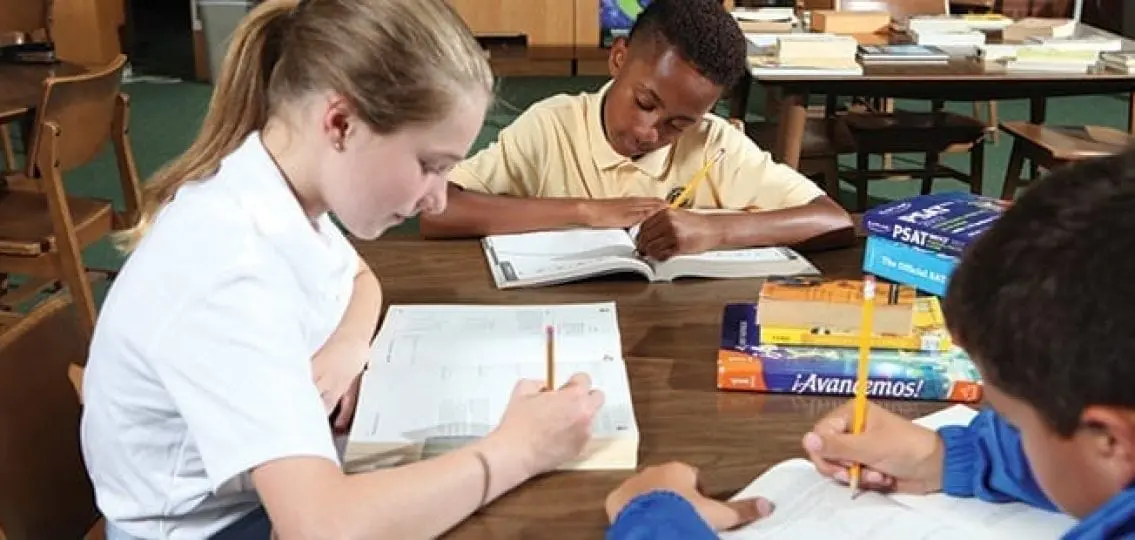College admissions can be high stakes. And we worry that our teenagers will get behind in the process. Often, parents feel a responsibility to give their teenagers every academic advantage as early as possible. Earlier is better, right? If that assumption is accurate, then is earlier also better for college testing?

Relax, say college admissions testing experts. For the majority of students, there’s no need to break out the ACT or SAT study guides until the summer before junior year. Along the way, there are things students can do to prepare. Here’s what your teenager can do from 8th grade through 11th grade.
8th and 9th Graders Need to Know:
1. Focus on schoolwork, not test prep.
Younger students can still work on skills that help with college testing. “The best thing is to focus on schoolwork,” says Megan Dorsey, test prep expert and founder of the Houston-based College Prep Results. Take rigorous courses that help build critical thinking, problem-solving, and math skills. Read fiction and nonfiction texts from many subjects to help develop a strong college-bound vocabulary in all content areas.
2. The PSAT 8/9 can be taken to qualify for special programs.
[adrotate banner=”24″]Taking this test can be advantageous for students who are trying to get college credit for high school courses through their state’s dual enrollment program, explains Cecilia Castellano, vice provost at Bowling Green State University. “In Ohio, for example, the College Credit Plus program allows students as young as 7th grade to take high school courses and earn college credit, provided the student can meet the same admissions requirements as a regular applicant. An early PSAT score can be used to demonstrate that a student is qualified,” says Castellano.
3. Some extracurricular programs may require a college admissions score.
Most families won’t need to think about college testing before 10th grade, but some programs for academically gifted students may require that they take PSAT 8/9, SAT, or ACT to get in. Two examples: the Duke TIP program and the Johns Hopkins Center for Talented Youth. Seventh graders and older qualify with SAT/ACT scores. These highly academic programs are suitable for academically gifted children only.
Sophomores Need to Know:
1. Sophomore year is a typical time to start taking tests.
Most schools administer the PSAT (the preliminary SAT) in fall of sophomore year as a practice test for the junior year PSAT and SAT. The PSAT exam isn’t an admissions test. And colleges never receive the scores. The purpose is to provide SAT practice and to identify top testers who might qualify for National Merit scholarships if they take the PSAT again junior year.
A PreACT (formerly the ACT Plan) is a sophomore-level practice test for the ACT. But only students whose schools offer the PreACT can take it because the test isn’t available to the general public. The PreACT isn’t tied to scholarship opportunities and, like the PSAT, the results are not sent to colleges.
2. There’s no need to prepare for the PSAT sophomore year.
According to experts, prepping in 8th or 9th grade for the PSAT is unnecessary. Even sophomores needn’t prepare, says Jed Applerouth, founder of Atlanta-based Applerouth Testing. “For the vast majority of students, prepping in 9th or 10th grade is an inefficient use of time,” Applerouth says. “We see tremendous gains when students begin prepping for the SAT or ACT after sophomore year.”
3. If possible, figure out which test—ACT or SAT—is the best fit.
If your student does not take the PreACT sophomore year, encourage them to try a full-length practice ACT at home. Students can get free practice tests at their school’s college counselor office or online. Compare the experience with the PSAT. The tests are more similar than ever, thanks to recent changes to the PSAT/SAT, but there are still some differences: the SAT has three sections, while the ACT has four, for example.
4. Sophomores taking AP classes should take subject tests.
Sophomores taking AP classes are required to take the AP tests for those classes in the spring. Experts recommend these sophomores also take the corresponding SAT subject tests. Many competitive colleges require students to submit two or more subject tests, so it’s worth taking them while the material is still fresh in your student’s mind.
Juniors Need to Know:
1. Juniors can take the PSAT again, but for most it’s not worth it.
If students score very high (typically in the top 2 percent) on the junior-year PSAT, they may earn National Merit recognition and college scholarships. It’s the only reason students should take the PSAT as juniors, explains Dorsey. Students who score in the top 5 to 10 percent on the PSAT during sophomore year would do well to study for the junior PSAT for a chance to qualify for National Merit.
2. Focus on the test which best suits you.
Which test suits your student better (feels easier, less stressful, etc.)? Use the results to decide which official admissions test—the SAT or the ACT—your student will take junior year. The results can also help identify areas for improvement (math, reading comprehension, etc.). While many juniors take both the ACT and SAT, focusing on one is often more effective and less expensive. “I encourage taking each test once to see which test you perform better on,” says Castellano. “Then take the better test for you a second time, because your results generally go up a little after the first sitting.”
[adrotate banner=”31″]
3. Take at least a month to prepare for the test.
Most students take their first official ACT or SAT test sometime during junior year. If your student plans to take the test during fall of junior year, then they should start preparing the summer before. Allowing one month or more to prep for the junior year SAT or ACT is key, whether studying independently, taking a class, or working with a tutor. Don’t cram the night before!

4. Take SAT subject tests if you need to.
The end of junior year is a good time to take SAT subject tests.




